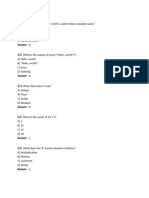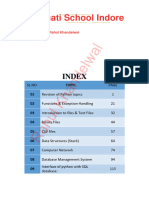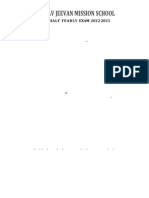0 ratings0% found this document useful (0 votes)
5 viewsPython Variables Quiz for 8th Grade
Uploaded by
lunakahwaji1212Copyright
© © All Rights Reserved
We take content rights seriously. If you suspect this is your content, claim it here.
Available Formats
Download as DOCX, PDF, TXT or read online on Scribd
0 ratings0% found this document useful (0 votes)
5 viewsPython Variables Quiz for 8th Grade
Uploaded by
lunakahwaji1212Copyright
© © All Rights Reserved
We take content rights seriously. If you suspect this is your content, claim it here.
Available Formats
Download as DOCX, PDF, TXT or read online on Scribd
You are on page 1/ 3
Python Variables Quiz for 8th Grade
1. What is a variable in Python?
a. A container for storing data values
b. A type of loop
c. A mathematical operation
d. A built-in function
2. Which of the following is a valid variable name in Python?
a. 2myVariable
b. my-variable
c. my_variable
d. my variable
3. What symbol is used to assign a value to a variable in Python?
a. ==
b. :=
c. ->
d. =
4. Which of these is NOT a valid way to declare a variable in Python?
a. x = 5
b. y = "Hello"
c. z := 3.14
d. var int a = 10
5. What will be the output of the following code: x = 5; x = x + 1; print(x)
a. 5
b. 6
c. 1
d. Error
6. Which data type is used for whole numbers in Python?
a. float
b. int
c. str
d. bool
7. What is the correct way to create a variable named 'age' with a value of 13?
a. 13 = age
b. age == 13
c. variable age = 13
d. age = 13
8. In Python, which statement is true about variable names?
a. They can start with a number
b. They are case-sensitive
c. They can contain spaces
d. They must be in all caps
9. What will be the value of 'y' after this code: x = 10; y = x
a. x
b. 10
c. 0
d. None
10. Which of the following is an example of a floating-point variable?
a. age = 13
b. name = "Alice"
c. is_student = True
d. height = 5.2
11. What happens if you try to use a variable before assigning a value to it?
a. It automatically gets assigned a value of 0
b. Python assigns it a random value
c. You get a NameError
d. The program crashes
12. How can you check the data type of a variable in Python?
a. checktype(variable)
b. variable.type()
c. type(variable)
d. datatype(variable)
13. What will be the output of: x = 5; x += 3; print(x)
a. 5
b. 3
c. 8
d. 15
14. Which of these is a valid way to create multiple variables with the same value?
a. x, y, z == 1, 1, 1
b. x = y = z = 1
c. x = 1 & y = 1 & z = 1
d. (x, y, z) <- (1, 1, 1)
15. What is the purpose of using variables in programming?
a. To make the code longer
b. To store and manipulate data
c. To create loops
d. To define functions
16. In Python, which of these is NOT a valid variable name?
a. _myvar
b. myVar
c. MYVAR
d. class
17. What will be the value of 'z' after this code: x = 5; y = 2; z = x * y
a. 7
b. 52
c. 10
d. 25
18. Which statement about Python variables is false?
a. Variables can change type during program execution
b. Variables must be declared with a specific type
c. Variables can be reassigned new values
d. Variables can hold different types of data
19. What does the following code do? x, y = 10, 20
a. Creates a list with values 10 and 20
b. Assigns 10 to x and 20 to y
c. Causes an error
d. Creates a tuple with values 10 and 20
20. Which of the following is an example of a string variable?
a. grade = 7
b. pi = 3.14
c. message = "Hello, World!"
d. is_python = True
You might also like
- Shu-Cherng Fang, Sarat Puthenpura - Linear Optimization and Extensions - Theory and Algorithms-Prentice Hall College Div (1993) PDFNo ratings yetShu-Cherng Fang, Sarat Puthenpura - Linear Optimization and Extensions - Theory and Algorithms-Prentice Hall College Div (1993) PDF320 pages
- Advanced C++ Interview Questions You'll Most Likely Be AskedFrom EverandAdvanced C++ Interview Questions You'll Most Likely Be AskedNo ratings yet
- Graded: AI Concepts, Terminology, and Application AreasNo ratings yetGraded: AI Concepts, Terminology, and Application Areas2 pages
- Python Sample Viva Questions for Academic Session 2024-2025No ratings yetPython Sample Viva Questions for Academic Session 2024-20256 pages
- Quiz:Variables Expressions and StatementsNo ratings yetQuiz:Variables Expressions and Statements3 pages
- 1-Python Input, Output, Variables and Operators - Print - QuizizzNo ratings yet1-Python Input, Output, Variables and Operators - Print - Quizizz16 pages
- Programming in Python Mcqs With Answers (2022) CsdNo ratings yetProgramming in Python Mcqs With Answers (2022) Csd63 pages
- Q1 Single Line Comments in Python Begin With Symbol.: Most Important Multiple Choice QuestionsNo ratings yetQ1 Single Line Comments in Python Begin With Symbol.: Most Important Multiple Choice Questions17 pages
- UNIT-1 Introduction To Python ProgrammingNo ratings yetUNIT-1 Introduction To Python Programming10 pages
- REVISION WORKSHEET 1- PYTHON(MIX BAG) docxNo ratings yetREVISION WORKSHEET 1- PYTHON(MIX BAG) docx25 pages
- 42-81 getting started with python and python fundamentals onlineNo ratings yet42-81 getting started with python and python fundamentals online40 pages
- FALLSEMFRE2024-25_CSE1012_ETH_AP2024253000300_2024-10-14_Reference-Material-INo ratings yetFALLSEMFRE2024-25_CSE1012_ETH_AP2024253000300_2024-10-14_Reference-Material-I24 pages
- Rev 1 _ q With Ans _python Basics and Flow Control 17.08.24No ratings yetRev 1 _ q With Ans _python Basics and Flow Control 17.08.247 pages
- XI-IP-Python Fundamentals-Module - III-Jun-14-2021No ratings yetXI-IP-Python Fundamentals-Module - III-Jun-14-20219 pages
- PEPS QB_Problem Solving Techniques & Python FundamentalsNo ratings yetPEPS QB_Problem Solving Techniques & Python Fundamentals4 pages
- Comprehensive Python Question Bank with AnswersNo ratings yetComprehensive Python Question Bank with Answers10 pages
- Student Support Material Class Xii - CsNo ratings yetStudent Support Material Class Xii - Cs150 pages
- IP - Computer Science - MCQs - SW - 2 - Q + SolnNo ratings yetIP - Computer Science - MCQs - SW - 2 - Q + Soln7 pages
- Netskope Security Service Edge (SSE) : Solution BriefNo ratings yetNetskope Security Service Edge (SSE) : Solution Brief6 pages
- [FREE PDF sample] Gray Hat Hacking: The Ethical Hacker's Handbook, Fifth Edition Daniel Regalado ebooks100% (2)[FREE PDF sample] Gray Hat Hacking: The Ethical Hacker's Handbook, Fifth Edition Daniel Regalado ebooks62 pages
- HUAWEI WKG-LX9 Hw-Meafnaf Software Upgrade Guideline - R3No ratings yetHUAWEI WKG-LX9 Hw-Meafnaf Software Upgrade Guideline - R310 pages
- STAT 451: Introduction To Machine Learning Lecture NotesNo ratings yetSTAT 451: Introduction To Machine Learning Lecture Notes22 pages
- Cyber Security of Mobile Applications Using Artificial IntelligenceNo ratings yetCyber Security of Mobile Applications Using Artificial Intelligence6 pages
- Transfer Learning Convolutional Neural Network-AlexNet Achieving Face RecognitionNo ratings yetTransfer Learning Convolutional Neural Network-AlexNet Achieving Face Recognition4 pages
- Job Description Template Download 20171005No ratings yetJob Description Template Download 201710052 pages
- Palo Alto Networks Cybersecurity Academy: Perimeter-Based Security ModelsNo ratings yetPalo Alto Networks Cybersecurity Academy: Perimeter-Based Security Models7 pages
- Information Bulletin - PHD M.Tech (R) M.Tech (S) - 2023No ratings yetInformation Bulletin - PHD M.Tech (R) M.Tech (S) - 202318 pages
- Data Domain 401: Link Aggregation, BOOST, and IfgroupsNo ratings yetData Domain 401: Link Aggregation, BOOST, and Ifgroups32 pages

























































































